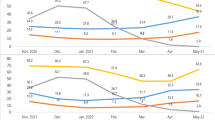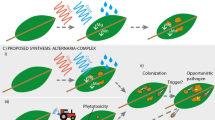Abstract
The possibility of suppressingAlternaria dauci (Kühn) Groves & Skolko, the causal agent of Alternaria leaf blight in carrot, by excess application of fertilizer was examined in greenhouse and field experiments. Reducing the rate of fertilization by one half from the optimal rate (100 ppm N, 19 ppm P and 74 ppm K) resulted in a 23–30% increase in the severity of Alternaria leaf blight. However, doubling the rate of fertilization resulted in only a 10–15% decrease in disease severity. Inoculating with different concentrations ofA. dauci spores (103 or 104 spores/ml) did not alter the response of the plants to the fertilization rate, although significantly higher disease severity was observed in plants inoculated with the higher spore concentration. These results were corroborated in the field, where neither disease severity nor harvested yield was significantly affected by tripling the amount of soil fertilization. Application of foliar fungicides, on the other hand, had substantial effects on both disease and yield. Therefore, it was concluded that carrot crops should be fertilized and maintained for optimum yield, and thatA. dauci should be managed by properly timed applications of fungicides during the growing season.
Similar content being viewed by others
References
Barclay, G.M., Murphy, H.J., Manzer, F.E. and Hutchinson, F.E. (1973) Effects of different rates of nitrogen and phosphorus on early blight in potatoes.Am. Potato J. 50:42–48.
Goodman, R.N., Kiraly, Z. and Wood, K.R. (1986) The Biochemistry and Physiology of Plant Diseases. University of Missouri Press, Columbia, MO, USA.
Harrison, M.D., Livingston, C.H. and Oshima, N. (1965) Epidemiology of early blight in Colorado. Initial infection, disease development and the influences of environmental factors.Am. Potato J. 42:279–291.
Hillcoks, R.J. and Chindoya, R. (1989) The relationship between Alternaria leaf spot and potassium deficiency causing premature defoliation of cotton.Plant Pathol. 38:502–508.
Horstall, J.G. and Heuberger, J.K. (1942) Causes, Effects and Control of Defoliation on Tomatoes.Conn. Agric. Exp. Stn. Bull. (New Haven) 456.
Jones, J.B. Jr. (1997) Hydroponics. A Practical Guide for Soilless Growers. St. Lucie Press, Boca Raton, FL, USA.
Jones, J.B. Jr., Wolf, B. and Milles, H.A. (1991) Plant Analysis Handbook. A Practical Sampling, Preparation, Analysis, and Interpretation Guide. Micro-Macro Publ. Inc., Athens, GA, USA.
Langesberg, W.J., Sutton, J.C. and Gillespie, T.J. (1977) Relation of weather variables and periodicities of airborne spores ofAlternaria dauci.Phytopathology 67:879–883.
MacKenzie, D.R. (1981) Association of potato early blight, nitrogen fertilizer rate and potato yield.Plant Dis. 65:575–577.
Miller, J. W. (1969) The effect of soil moisture and plant nutrition onCercospora—Alternaria leaf blight complex of cotton in Missouri.Phytopathology 59:767–769.
Netzer, D. and Kenneth, R.G. (1969) Persistence and transmissionof Alternaria dauci (Kühn) Groves & Skolko in the semi-arid conditions of Israel.Ann. Appl. Biol. 63:289–294.
Rotem, J. (1981) Fungal diseases of potato and tomato in the Negev region.Plant Dis. 65:315–318.
Rotem, J. (1994) The GenusAlternaria. Biology, Epidemiology and Pathogenicity. American Phytopathological Society Press, St. Paul, MN, USA.
Shtienberg, D. and Dreishpoun, J. (1991) Suppression of Alternaria leaf spot in Pima cotton by systemic fungicides.Crop Prot. 10:381–385.
Snell, F.D. and Snell, C.T. (1959) Calorimetric Methods of Analysis. Vol. II. 4th ed. D. Van Nostrand Company, Inc., Princeton, NJ, USA.
Soltanpour, P.N. and Harrison, M.D. (1974) Interrelations between nitrogen and phosphorus fertilization and early blight control of potatoes.Am. Potato J. 51:1–7.
Author information
Authors and Affiliations
Corresponding authors
Additional information
Contribution no. 533/99 from the Inst. of Plant Protection, Agricultural Research Organization.
Rights and permissions
About this article
Cite this article
Vintal, H., Ben-Noon, E., Shlevin, E. et al. Influence of rate of soil fertilization on alternaria leaf blight (Alternaria dauci) in carrots. Phytoparasitica 27, 193–200 (1999). https://doi.org/10.1007/BF02981458
Received:
Revised:
Issue Date:
DOI: https://doi.org/10.1007/BF02981458




